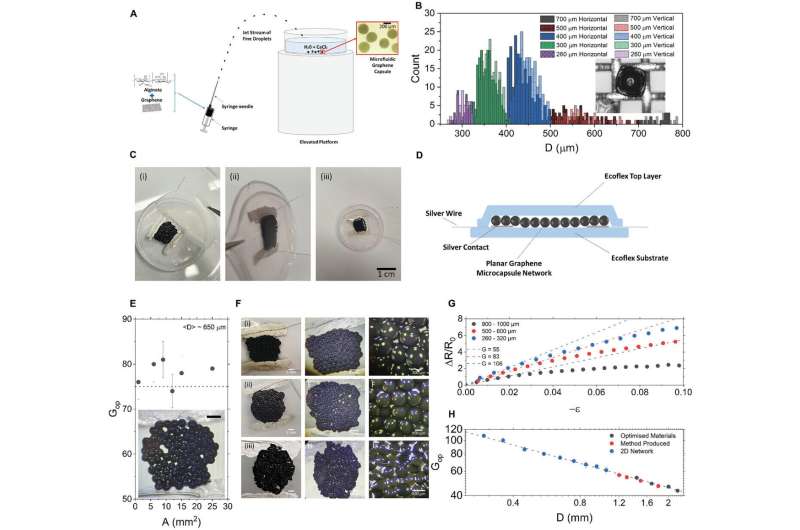This article has been reviewed according to Science X's editorial process and policies. Editors have highlighted the following attributes while ensuring the content's credibility:
fact-checked
peer-reviewed publication
trusted source
proofread
'Electronic skin' from bio-friendly materials can track human vital signs with ultrahigh precision

Currently much of the research on nanocomposite-based sensors is related to non-sustainable materials. This means that these devices contribute to plastic waste when they are no longer in use. A new study, published on 28 June in Advanced Functional Materials, shows for the first time that it is possible to combine molecular gastronomy concepts with biodegradable materials to create devices that are not only environmentally friendly, but also have the potential to outperform the non-sustainable ones.
Scientists used seaweed and salt, two very commonly used materials in the restaurant industry, to create graphene capsules made up of a solid seaweed/graphene gel layer surrounding a liquid graphene ink core. This technique is similar to how Michelin star restaurants serve capsules with a solid seaweed/raspberry jam layer surrounding a liquid jam core.
Unlike the molecular gastronomy capsules though, the graphene capsules are very sensitive to pressure; so, when squeezed or compressed, their electrical properties change dramatically. This means that they can be utilized as highly efficient strain sensors and can facilitate the creation of smart wearable skin-on devices for high precision, real-time biomechanical and vital signs measurements.
Dr. Dimitrios Papageorgiou, Lecturer in Materials Science at Queen Mary University of London, said, "By introducing a ground-breaking fusion of culinary artistry and cutting-edge nanotechnology, we harnessed the extraordinary properties of newly created seaweed-graphene microcapsules that redefine the possibilities of wearable electronics.
"Our discoveries offer a powerful framework for scientists to reinvent nanocomposite wearable technologies for high precision health diagnostics, while our commitment to recyclable and biodegradable materials is fully aligned with environmentally conscious innovation."
This research can now be used as a blueprint by other labs to understand and manipulate the strain sensing properties of similar materials, pushing the concept of nano-based wearable technologies to new heights.
The environmental impact of plastic waste has had a profound effect on our livelihoods and there is a need for future plastic-based epidermal electronics to trend towards more sustainable approaches. The fact that these capsules are made using recyclable and biodegradable materials could impact the way we think about wearable sensing devices and the effect of their presence.
Dr. Papageorgiou said, "We are also very proud of the collaborative effort between Dr. Conor Boland's group from University of Sussex and my group from Queen Mary University of London that fueled this ground-breaking research. This partnership exemplifies the power of scientific collaboration, bringing together diverse expertise to push the boundaries of innovation."
More information: Adel K. A. Aljarid et al, Smart Skins Based on Assembled Piezoresistive Networks of Sustainable Graphene Microcapsules for High Precision Health Diagnostics, Advanced Functional Materials (2023). DOI: 10.1002/adfm.202303837
Journal information: Advanced Functional Materials
Provided by Queen Mary, University of London



















